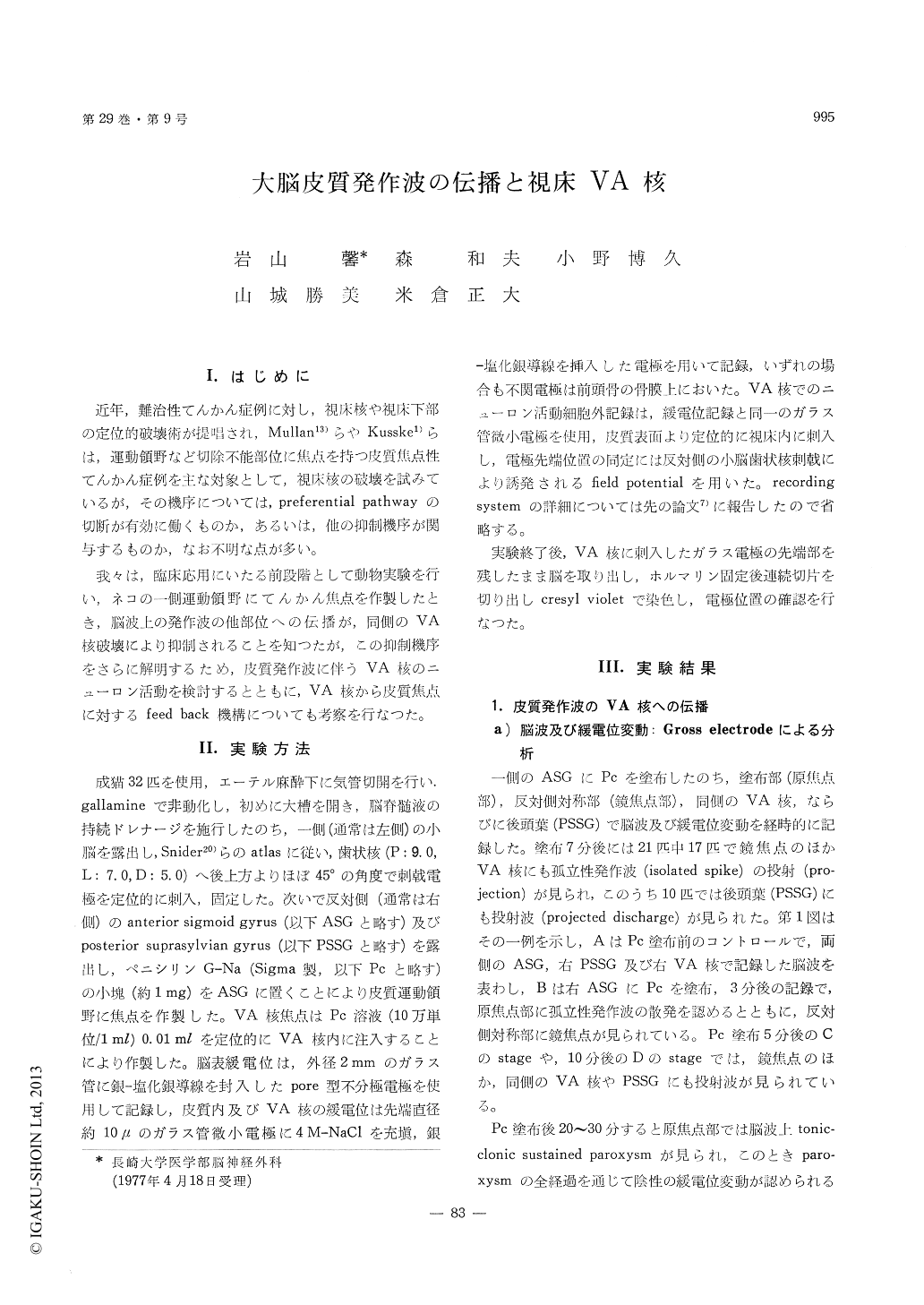Japanese
English
- 有料閲覧
- Abstract 文献概要
- 1ページ目 Look Inside
I.はじめに
近年,難治性てんかん症例に対し,視床核や視床下部の定位的破壊術が提唱され,Mullan13)らやKusske1)らは,運動領野など切除不能部位に焦点を持つ皮質焦点性てんかん症例を主な対象として,視床核の破壊を試みているが,その機序については,preferential pathwayの切断が有効に働くものか,あるいは,他の抑制機序が関与するものか,なお不明な点が多い。
我々は,臨床応用にいたる前段階として動物実験を行い,ネコの一側運動領野にてんかん焦点を作製したとき,脳波上の発作波の他部位への伝播が,同側のVA核破壊により抑制されることを知つたが,この抑制機序をさらに解明するため,皮質発作波に伴うVA核のニューロン活動を検討するとともに,VA核から皮質焦点に対するfeed back機構についても考察を行なつた。
Epileptic focus was produced by topical appli-cation of penicillin in the motor cortex of cats, andsteady potential shifts and extracellular neuronalactivities associated with ECoG paroxysms wererecorded in VA neucleus of the thalamus, in orderto study the effects of projected epileptiform dis-charges on cellular activities in VA nucleus andfeedback mechanism from the thalamus to thecortical focus.
1) During interictal stage, in which isolatedspikes in ECoG were observed, projected spikeswere recognized in VA nucleus in about two-thirdof the cases. During ictal stage, in which tonic-clonic sustained paroxysm was observed on thecortical focus, projected epileptiform dischargesfrom the VA nucleus remained in "larval form"in many cases, without accompanying negativesteady potential shift. In few occasions, however,epileptiform discharges from VA nucleus showedtypical sustained paroxysms which were associatedwith negative steady potential shift.
2) VA focus was produced by injecting penicillininto the nucleus and propagated epileptiform dis-charges from the VA focus were recognized in theanterior sigmoid gyrus bilaterally. Laminar analysisrevealed that 300-500 μV of negative steady po-ential shift associated with paroxysm was observedin all cortical layers.
3) Cortical epileptogenic focus which had pro-duced in advance, was markedly enhanced bymaking additional penicillin focus to the VAnucleus.
4) In the "VA-VL area" of the thalamus, therenoted neurons responding antidromically to stimu-lation of the anterior sigmoid gyrus, and theseneurons were considered to be thalamocortical relayneurons. During interictal stage, some of theserelay neurons exhibited cessation of unitary dis-charges correlated with epileptiform discharges inECoG, and some of other neurons showed indifferentfiring. This fact suggested that even in this stage,inhibitory mechanisms acting on relay neuron werestill preserved. In more advanced ictal stage,however, all of relay neurons recorded, showedhigh frequency firing similar to those observed atthe cortical focus, suggesting that relay neuronswere fell into the condition of "epileptic neuronalaggregate" and which resulted in the secondaryactivation (positive feed-back) to the cortical focus.

Copyright © 1977, Igaku-Shoin Ltd. All rights reserved.


